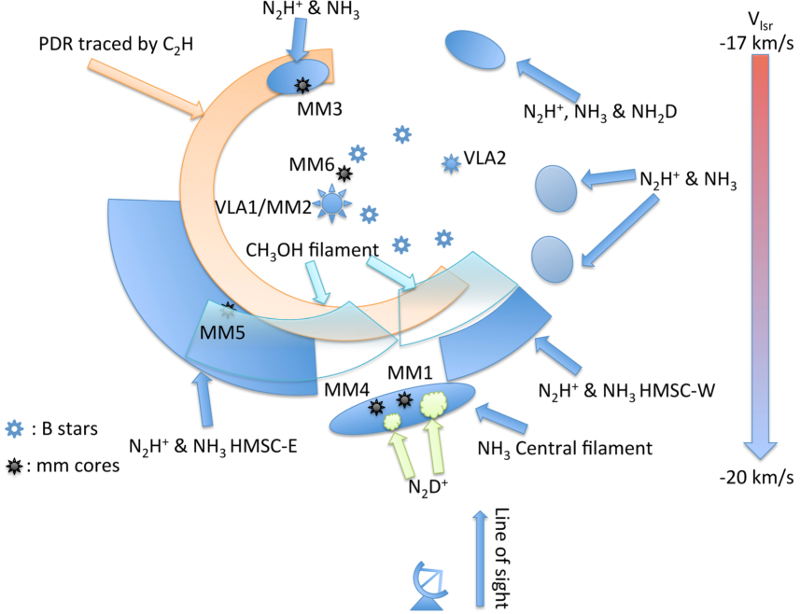| EPoS Contribution |
|
Ongoing star formation in the proto-cluster IRAS 22134+5834
Yuan Wang MPIA, Heidelberg, DE | |
| Massive stars form in clusters, and their influence on nearby starless cores is still poorly understood. The protocluster associated with IRAS 22134+5834 represents an excellent laboratory to study the influence of massive YSOs on nearby starless cores, and the possible implications in the clustered star formation process. IRAS 22134+5834 was observed in the centimeter with (E)VLA, 3 mm with CARMA, 2 mm with PdBI, and 1.3 mm with SMA, to study the continuum emission as well as the molecular lines, that trace different physical conditions of the gas. The multi-wavelength centimeter continuum observations revealed two radio sources within the cluster, VLA1 and VLA2. VLA1 is considered to be an optically thin UCHii region with a size of 0.01 pc and sits at the edge of the near-infrared (NIR) cluster. The flux of ionizing photons of the VLA1 corresponds to a B1 ZAMS star. VLA2 is associated with an infrared point source and has a negative spectral index. We resolved six millimeter continuum cores at 2 mm, MM2 is associated with the UCHii region VLA1, and other dense cores are distributed around the UCHii region. Two high-mass starless clumps (HMSC), HMSC-E (east) and HMSC-W (west), are detected around the NIR cluster with N2H+(1-0) and NH3 emission, and show different physical and chemical properties. Two N2D+ cores are detected on an NH3 filament close to the UCHii region, with a projected separation of ~8000 AU at the assumed distance of 2.6 kpc. The kinematic properties of the molecular line emission confirm the expansion of the UCHii region and that the molecular cloud around the near infrared (NIR) cluster is also expanding. Our multi-wavelength study has revealed different generations of star formation in IRAS 22134+5834. The formed intermediate- to massive stars show strong impact on nearby starless clumps. We propose that while the stellar wind from the UCHii region and the NIR cluster drives the large scale bubble, the starless clumps and HMPOs formed at the edge of the cluster. | |
 | |
| Caption: The general picture of I22134 according to the kinetic properties of the molecular line observations, not scaled. The blue ellipses and block mark the dense clouds traced by different molecules as marked in the figure, the two green clouds mark the N2D+ cores, the orange arc shows the PDR traced by C2H, the light blue blocks show the possible shocked emission traced by CH3OH, the small stars mark the B stars in the cluster (Kumar et al. 2003), the big filled star marks the UCHii region VLA1, the small filled star marks VLA2, the black stars mark the millimeter cores from our observations. The antenna shows our observation point. | |
| Collaborators: M. Audard, UniGE, CH F. Fontani, INAF, IT A. Sanchez-Monge, U Cologne, DE G. Busquet, ICE, ES A. Palau, UNAM, MX H. Beuther, MPIA, DE |
Key publication
Suggested Session: Massive Star Formation |

